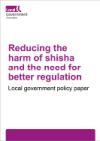This local government policy paper is solely concentrating on those aspects of the shisha industry that cause adverse health, safety and environmental impacts on local communities. These are impacts which councils and partners are unable to resolve through current legislative or other means available to them.
Why is shisha smoking a problem?
First and foremost, shisha smoking is harmful to health but the risks associated with shisha are not widely known or publicised. Whilst there is limited research on the impact of shisha smoking, emerging evidence suggests it has a range of adverse health impacts, including heart and circulatory diseases, cancers, nicotine addiction, carbon monoxide poisoning, bacterial infections and high blood pressure. Despite this, shisha is seen as a ‘safe’ alternative to cigarette smoking and continually falls outside of tobacco control harm reduction strategies and campaigns. This means there is a lack of trusted health information available for shisha smokers.
In addition to the health impacts of the activity itself, councils report that, in some instances, shisha bars negatively affect the local community, for example noise nuisance from amplified music or late-night disturbance. Regulatory officers report frequent breaches of planning regulations, as well as fire risk and anti-social behaviour, leading to enforcement issues for councils, fire authorities and police services. There are also concerns about illicit tobacco (non-duty paid) being found at shisha premises.
What are councils doing?
Councils have statutory duties to safeguard communities from harms. With responsibility for public health having transferred to councils on 1 April 2013, councils have greater scope to take account of health in our service provision and decision making.
However, there is no sole legislative provision or specific regulator which covers shisha activities. Councils enforce good management of shisha bars as best they can through the range of different legislative provisions, for instance environmental health and fire safety inspections, enforcement action on shisha premises in breach of smoke free regulations or planning permission, and serving community protection notices for anti-social behaviour. These measures often require a multi-agency approach which relies on resources being available from each regulatory authority to react and coordinate a response. This can mean that such preventative work is limited. Moreover, clarity of ownership and management of a business is not often forthcoming, which frustrates procedures to remedy issues.
Why is the current regulatory framework insufficient?
There are several pieces of legislation relevant to shisha smoking, but these currently fail to provide councils with the necessary tools to deal with shisha premises. These issues are detailed later in the report, but cover applications of the Health Act, Tobacco and Related Products Regulations, Health and Safety at Work, and Trading Standards. Shisha falls through the gaps in each of these areas, either because penalties and prosecutions are not acting as enough of a deterrent, or because regulations which apply to cigarettes and hand-rolling tobacco are not equally applied to shisha, despite the parallel risks of shisha smoking.
There are particularly concerning loopholes, for example, around the lack of application of flavoured tobacco legislation to shisha, which makes it seem more appealing and less dangerous. Labelling regulations, including health warnings which are now mandatory on cigarette packaging, are also aimed at retail rather than shisha served in cafes, where pipes, mouthpieces and menus do not warn consumers of shisha’s serious health impacts.
What is needed from central government?
We have two asks of government. Firstly, we believe that shisha should be brought within the scope of the UK Tobacco Control Strategy. This would be a crucial addition to the strategy owing to the serious health consequences and community impacts of shisha detailed in this paper. It is welcome that ‘The Khan Review: Making smoking obsolete’ makes some reference to shisha. However, a greater focus on the harms caused by shisha in the UK Tobacco Control Strategy would demonstrate government’s commitment to protecting public health and promoting responsible management of shisha premises. Moreover, there has been welcome action taken by Government recently to deliver a smokefree 2030, including legislating to raise the age of sale one year every year from 2027 onwards, doubling the funding for local authority Stop Smoking Services from 2024, increasing funding for awareness raising campaigns and for enforcement on illicit tobacco and e-cigarettes. The lack of specific provisions on shisha are a notable omission, and it is important that Government considers shisha within this work, as well as commissions additional research on the health risks of shisha. This will also help to ensure that the health impacts of shisha are more widely understood by society.
Secondly, we believe that the Government should introduce a licensing regime to better regulate shisha premises. This could be achieved by amending the Local Government (Miscellaneous Provisions) Act 1982 or the Licensing Act 2003. This would give councils the powers to grant or refuse licences for new shisha premises, to add conditions to licences to improve safety or mitigate potential community impacts (such as noise nuisance), and the power to revoke or suspend licences in the event of non-compliance.
Although tobacco generally is not licensed, we believe it is reasonable to licence shisha premises because it is a venue specifically designed for consumption of a risky product which merits close oversight.

